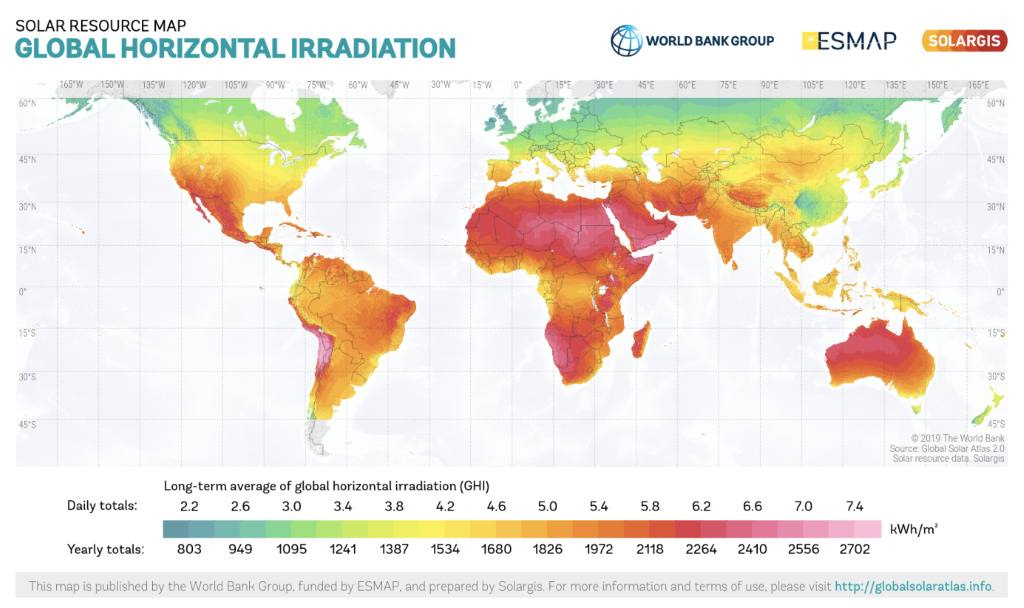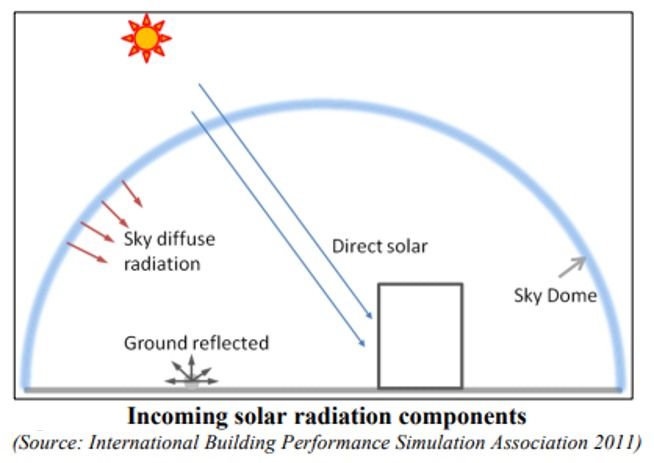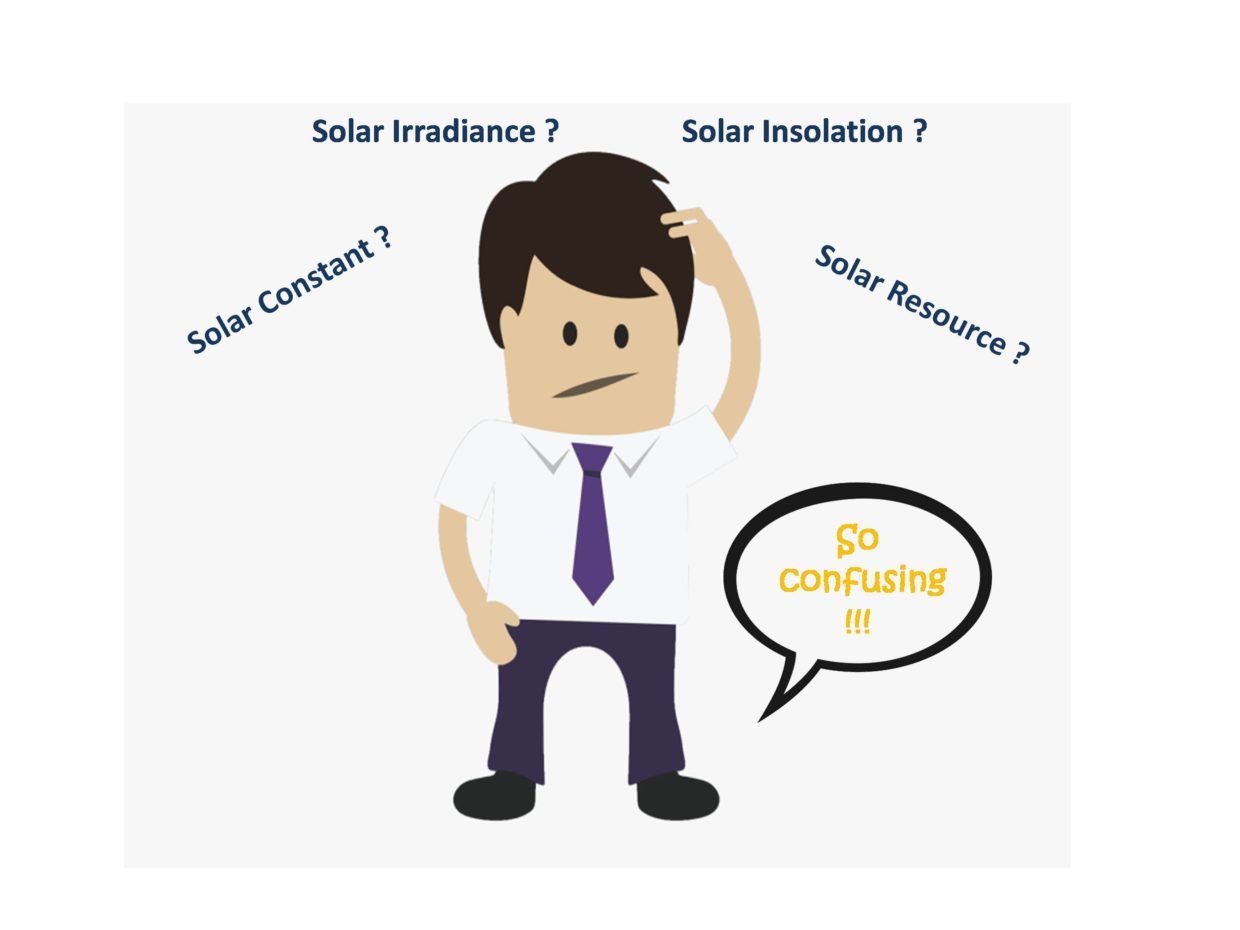A beginner’s guide to solar potential and its estimation

This article is Part 1 of a series about solar potential estimation. In this article we explore the fundamental aspects of solar potential. What is solar potential and what are the major factor on which it depends? We have also discussed about the various tools which are generally used for solar potential estimation.
For knowing more about solar potential estimation and various efforts made by India for large scale potential analysis check out Part 2 of the series.
Introduction
There is an abundance of solar energy received on earth’s surface. Energy that can produce electricity and then some for thermal applications. Over the last few decades’ solar energy harnessing devices have evolved from experiments to commercial applications. That is from proving a concept through practical applications in solar thermal and solar PV, we have arrived at large scale applications of these technologies. Use of this technology evolved from home-made solar cookers to the largest CSP in Spain and Portugal. Similarly, the world has seen electricity generation from solar PV rise to 638 GW in 2019 from a few MWs in early 2000s. Though electricity generation from solar makes up only 2% of total electricity produced worldwide. The rate of growth is poised to continue an upward trajectory. There are 3 main reasons for this claim
- Tariff rates are lower than other forms of energy such as gas/ coal powered thermal plants, if not better
- Independence from non-renewable resources whose availability is subject to geo political relations
- Commitments of nations and large organizations towards renewable energy sources to meet carbon emission targets
To enable billions of $ investment into solar energy, financial instruments have to mitigate risk. Secondly, one has to quantify the scope and reliability of energy output over 20+ years. Therefore, the knowledge and data around us have fueled smart mathematical and risk models.
In the next sections of the article we explore the concept of solar potential and its estimation in detail.
What is Solar Radiation:
Solar radiation is the electromagnetic radiation, including X-rays, ultraviolet and infrared radiation, and radio emissions, as well as visible light, emanating from the Sun. Around 3.8 × 1033 ergs is emitted by the Sun every second and a very small fraction is trapped by earth (on average 1.4 kilowatts per square metre)
This solar radiation can be captured and turned into useful forms of energy, such as heat and electricity, using various modern tools and technologies available.
The amount of radiation received by Earth depends on number of factors. These are –
- Geographic location
- Time of day
- Season
- Local landscape
- Local weather.
More is the travel path of the Sun’s radiation through the Earth’s atmosphere, more is the scattering and lesser is the energy received by the surface per unit area. Due to rounded shape of Earth, the sun rays hit the Earth’s surface at angles ranging between 0° to 90°. When the sun rays fall perfectly vertical (i.e., at 90°), least scattering takes place and energy received per unit area is maximum.
Due to elliptical orbit of Earth’s revolution, it is closer to the sun during certain time of the year. At that particular time, it receives a bit more of solar energy. The Earth is nearer to the sun when it is summer in the southern hemisphere and winter in the northern hemisphere.
The 23.5° tilt of earth’s axis of rotation significantly influences the amount of sunlight falling on the earth’s surface. Earth’s rotation is responsible for hourly variation in sunlight. At noon, the sun is perfectly overhead, resulting in least scattering and maximum energy received per unit area as compared to early morning and late afternoon. This is the reason behind solar panels producing peak power mostly during noon.
The tilt angle causes a peculiar sun path as perceived from earth. Hence, the same panels produce more electricity in summer months.
Types of Radiation:
The solar radiation has to travel through several layers of Earth’s atmosphere to finally reach the surface. While travelling through these layers, these rays get scattered, absorbed and reflected by various particles and gases which remain suspended in the atmosphere.

The major elements responsible for scattering, absorption and reflection of radiations are:
- Water vapor
- Clouds
- Dust particle
- Pollutants
- Forest fires
- Volcanoes.
The radiation then incident on the Earth’s surface is referred to as diffused solar radiation. The solar radiation that reaches the Earth’s surface without being diffused is called direct beam solar radiation. The sum of the diffuse and direct solar radiation is called global solar radiation. The above terms are also used interchangeably with Diffuse Horizontal Irradiance (DHI), Direct Normal Irradiance (DNI) and Global Horizontal Irradiance (GHI).
Earth. It is the sum of direct irradiance (after accounting for the solar zenith angle of the sun z) and diffuse horizontal irradiance.
GHI = DHI + DNI × cos(z)

About 5,000 trillion kWh per year energy is incident over India’s land area with most parts receiving 4-7 (kWh/m2) per day.
How is it measured and denoted?
Solar radiation is measured in terms of either wavelength or frequency. Solar radiations travel in the form of wave and thus have some wavelength corresponding to a particular range of electromagnetic spectrum. Wavelength is defined as the distance between consecutive peaks of a wave.
The relation between Energy (E) and Wavelength (⅄) is given by the equation:
E=hc/⅄
Where, h = Planck’s constant and c = speed of light
Measurements of solar energy are then typically expressed as total radiation on a horizontal surface or as total radiation on a surface tracking the sun. To measure this data we use tools like pyranometer.
Radiation data for solar electric (photovoltaic) systems are often represented as kilowatt-hours per square meter (kWh/m2). Direct estimates of solar energy may also be expressed as watts per square meter (W/m2).
What is solar potential?
The potential solar energy that can be harnessed by humans by using Photovoltaic systems for electricity generation or for solar water heating for a given location is termed as solar potential for that area. Solar potential again varies from place to place on Earth and depends on various factors such as sun angle, air mass, day length, cloud coverage, and pollution levels.
Our Earth receives approximately 175 petawatts (PW) of solar radiation in the upper atmosphere out of which around 30% gets reflected back in space. Most of the world’s population lives in areas with insolation levels of 150–300 watts/m², or 3.5–7.0 kWh/m² per day.

Terms used interchangeably with solar potential:

- Solar Constant: Solar constant, the total radiation energy received from the Sun per unit of time per unit of area on a theoretical surface perpendicular to the Sun’s rays and at Earth’s mean distance from the Sun. The value of the constant is approximately 1.366 kW/m²
- Solar Irradiance: solar irradiance is defined as the amount of radiant energy emitted by the Sun over all wavelengths on a surface per unit time per unit area. Irradiance may be measured in space or at the Earth’s surface after atmospheric absorption and scattering.
- Solar Insolation: It is a measure of the solar energy that is incident on a specified area over a set period of time. Generally insolation is expressed two ways. One unit is kilowatt-hours per square meter (kWh/m2) per day which represents the average amount of energy hitting an area each day. Another form is watts per square meter (W/m2) which represents the average amount of power hitting an area over an entire year.
- Solar Resource: It refers to solar radiation energy in the form of electromagnetic energy that reaches Earth and is directly or indirectly utilized by humans.
Solar Potential Estimation tools:
Solar Potential Estimation is the accurate measurement of sun’s energy for different applications such as Photovoltaic systems for rooftop solar, solar water heating etc. These estimations help in sustainable development, energy policy making, and renewable energy consumption.
There are multiple tools available now to map the solar potential of any location and assist customers in understanding the potential costs and benefits of solar with just the click of a button. Some of these tools are mentioned below –
- PVWatts: developed by National Renewable Energy Laboratory (NREL), PVWatts calculatior is an online tool which estimates the energy production and cost of energy of grid-connected photovoltaic (PV) energy systems throughout the world. It allows homeowners, small building owners, installers and manufacturers to easily develop estimates of the performance of potential PV installations.
- PV-GIS: PVGIS is an online free solar photovoltaic energy calculator for stand alone or connected to the grid PV systems and plants, in Europe, Africa, America and Asia. Solar electricity generator simulation and solar radiations maps
- MYSUN: MYSUN’s rooftop solar calculator uses engineering, data and analytics to deliver the most suitable and customized solar solutions to residential, commercial and industrial energy consumers.
- Tata Power Solar Rooftop Calculator: It’s a simple online tool which predicts your monthly savings (in terms of units) from the kW solar rooftop system which can be installed based on your available rooftop area.
- GEOSTELLAR: It measures user’s solar potential based on satellite maps of their property, and estimates the financial benefit of such a system based on the user’s electricity bills.
- Solar Rooftop Calculator: Offered by Ministry of New And Renewable Energy which is an online application for Solar Photovoltaic Installation (Grid-Connected Rooftop). It calculates the available solar potential based on location, customer category and average monthly average consumption.
The above discussion highlights the importance of precise solar potential estimation and the factors on which solar potential depends. We also discussed about several other terms which are used interchangeably with solar potential and the tools which are generally used for mapping the potential of a rooftop.
In the next part of this series of article on solar potential estimation we will be discussing about the types of solar potential estimation and various efforts made by India for large scale solar potential analysis. Click here to go to next part.

